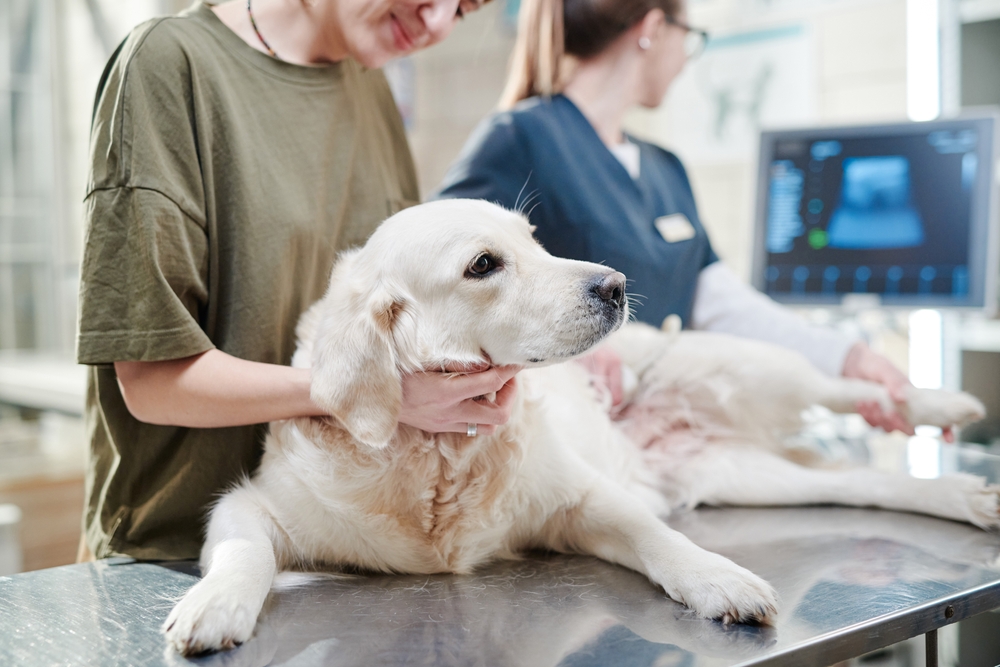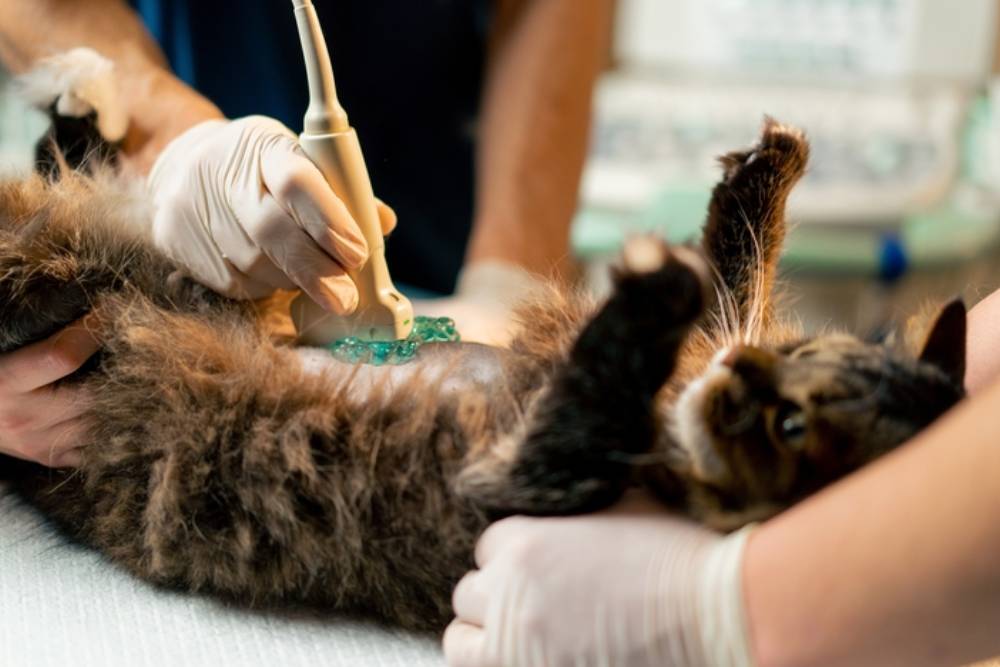How X-rays and Ultrasounds Help Diagnose Pet Health Problems
When pets become sick or injured, their symptoms often tell only part of the story. A cat that vomits for several days, a dog that starts limping, or a pet that suddenly struggles to breathe may be experiencing very different conditions, yet the signs can look similar on the surface. Without the right tools, it can be difficult to know exactly what is happening inside the body.
That is where imaging comes in. Digital X-rays and ultrasound allow veterinarians to look beyond the surface and uncover the real cause of your pet’s illness or injury. At Village Animal Hospital, we’re here to help your pet get the answers they need and the care they deserve, giving you peace of mind and a clear path forward.
Vomiting and Diarrhea
Digestive issues are among the most frequent reasons pets need imaging. Because diarrhea and vomiting can be caused by so many different conditions, using both imaging methods together often provides the clearest path to a diagnosis.
X-rays are especially useful for detecting swallowed objects, intestinal blockages, or gas patterns that indicate a serious obstruction. They can also reveal enlarged organs or emergency conditions such as gastric dilatation and volvulus (GDV), also known as bloat, which requires immediate attention. In chronic cases, X-rays may highlight abnormal shapes or masses that warrant further investigation.
Ultrasound provides a more detailed look at the stomach and intestinal walls, making it ideal for diagnosing conditions like inflammatory bowel disease or intestinal lymphoma. It also allows veterinarians to evaluate the pancreas and liver, both of which are common sources of gastrointestinal upset. In pets with unexplained or recurrent symptoms, ultrasound can help differentiate between functional digestive issues and structural disease, guiding the need for further testing or biopsy.
Coughing and Breathing Issues
Respiratory problems can be frightening to witness, and imaging plays a central role in determining the underlying cause.
X-rays are the first-line tool for evaluating the lungs, trachea, and heart size. They can reveal conditions like collapsed trachea in dogs, show patterns consistent with feline asthma, and detect pneumonia or fluid accumulation.
Ultrasound is less effective for air-filled lungs, but it can be valuable when there is fluid in the chest or when looking for tumors along the chest wall. It is also the best way to evaluate the heart. An echocardiogram allows veterinarians to assess chamber size, valve function, and blood flow, making ultrasound essential for diagnosing and managing heart disease.
In many cases, chest X-rays and a cardiac ultrasound are performed together, providing both a structural and functional view of the chest.
Limping and Orthopedic Problems
When pets develop lameness, stiffness, or sudden pain, imaging is often the fastest way to identify the cause.
X-rays are the primary diagnostic tool for bone and joint issues. They confirm fractures, reveal arthritis or hip dysplasia, and can detect bone tumors. After trauma, radiographs provide immediate answers that guide stabilization or surgical care. For broken bones, digital radiology provides quick and accurate imaging so treatment can begin without delay.
Ultrasound is rarely used in orthopedic cases but may occasionally help evaluate soft tissue structures like ligaments, tendons, or muscle injuries that do not appear on an X-ray. Even in these situations, ultrasound is typically a secondary tool rather than a first choice.
Because most orthopedic conditions affect bones and joints, X-rays remain the most effective and widely relied upon imaging method for diagnosing lameness in pets.
Dental Disease
Many dental problems remain hidden beneath the gumline, which is why imaging is considered standard in veterinary dentistry.
X-rays are essential for evaluating the roots of teeth. They reveal abscesses, fractures, impacted teeth, and resorptive lesions that would otherwise go unnoticed. During a dental procedure, radiographs help determine which teeth can be treated and which require extraction.
Ultrasound is not used for dental diagnostics, since bone and enamel block sound waves. This makes dental X-rays the most valuable tool for ensuring thorough and effective oral health care.
Urinary and Reproductive Health
Bladder, kidney, and reproductive problems are also common reasons for diagnostic imaging.
X-rays are especially helpful for detecting bladder and kidney stones, many of which appear clearly on radiographs. They can also reveal an enlarged prostate or uterine abnormalities such as pyometra. In pregnant pets, X-rays confirm the number and position of developing puppies or kittens once the skeletons are visible.
Ultrasound adds another layer of detail, allowing veterinarians to see the bladder wall, kidneys, and reproductive organs more closely. It can confirm pregnancy earlier than X-rays, detect uterine infections, and identify ovarian disease that might not be visible otherwise. While X-rays are excellent for detecting stones and fetal counts, ultrasound is more sensitive for soft tissue changes, so the two tests often complement each other.
Cancer Screening and Monitoring
Imaging is essential in both diagnosing cancer and tracking its progression.
X-rays reveal tumors in bones, lungs, and abdominal organs, and help determine whether cancer has spread to the chest cavity. Ultrasound is especially valuable for detecting soft tissue tumors, guiding biopsies, and evaluating internal organs for signs of spread.
For pets undergoing treatment, repeat imaging allows veterinarians to monitor whether tumors are shrinking, stable, or growing. Follow-up X-rays and ultrasounds ensure that therapies are adjusted appropriately and that families remain informed about their pet’s health.
What to Expect During Imaging
Pet owners often wonder how their dog or cat will handle an imaging appointment. At Village Animal Hospital, our AAHA accreditation demonstrates our dedication to patient comfort and safety during every procedure.
Ultrasound typically requires shaving a small patch of fur so the probe can make direct contact with the skin. The exam is painless, and most pets tolerate it well with gentle restraint. Because the procedure is noninvasive, sedation is rarely necessary.
X-rays, on the other hand, require pets to remain completely still. In some cases, especially when a pet is injured or in pain, sedation or even anesthesia may be recommended to achieve clear, accurate images and keep the patient comfortable. Our experienced team monitors every pet closely, ensuring their wellbeing throughout the process.
Both tests are safe. Radiation exposure from X-rays is very low, and ultrasound uses only sound waves, making it entirely risk-free. Together, these imaging tools allow veterinarians to obtain the answers needed while keeping pets safe and at ease.

When to Call Village Animal Hospital
Persistent vomiting, diarrhea, coughing, limping, unexplained weight loss, or sudden changes in behavior often require imaging to find the cause. Early diagnosis relieves discomfort and helps prevent serious complications.
At Village Animal Hospital, our philosophy of Limitless Care means you never face these challenges alone. We provide everything from wellness care and dental care to advanced diagnostics and surgery under the high standards of AAHA accreditation.
We offer emergency services during business hours and trusted after-hour referrals. For non-urgent needs, request an appointment online or call us at 316-689-0202. If your pet is showing signs of illness or pain, don’t wait- reach out today and let our experienced team provide the answers and care your pet deserves.








Leave A Comment